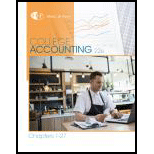
College Accounting, Chapters 1-27 (New in Accounting from Heintz and Parry)
22nd Edition
ISBN: 9781305666160
Author: James A. Heintz, Robert W. Parry
Publisher: Cengage Learning
expand_more
expand_more
format_list_bulleted
Textbook Question
Chapter 1, Problem 2SEB
ACCOUNTING PROCESS Match the following steps of the accounting process with their definitions.
Analyzing a. Telling the results
Recording b. Looking at events that have taken place and thinking about how they affect the business
Classifying
Summarizing c. Deciding the importance of the various reports
Reporting d. Aggregating many similar events to provide information that is easy to understand
Interpreting e. Sorting and grouping like items together
f. Entering financial information into the accounting system
Expert Solution & Answer
Want to see the full answer?
Check out a sample textbook solution
Students have asked these similar questions
The following data were selected from the records of Fluwars Company for the year ended December 31, current year:
Balances at January 1, current year:
Accounts receivable (various customers)
$
111,500
Allowance for doubtful accounts
11,200
The company sold merchandise for cash and on open account with credit terms 1/10, n/30, without a right of return.
The following transactions occurred during the current year:
Sold merchandise for cash, $252,000.
Sold merchandise to Abbey Corp; invoice amount, $36,000.
Sold merchandise to Brown Company; invoice amount, $47,600.
Abbey paid the invoice in (b) within the discount period.
Sold merchandise to Cavendish Inc.; invoice amount, $50,000.
Collected $113,100 cash from customers for credit sales made during the year, all within the discount periods.
Brown paid its account in full within the discount period.
Sold merchandise to Decca Corporation; invoice amount, $42,400.
Cavendish paid its account in full after the…
None
Give me solution
Chapter 1 Solutions
College Accounting, Chapters 1-27 (New in Accounting from Heintz and Parry)
Knowledge Booster
Learn more about
Need a deep-dive on the concept behind this application? Look no further. Learn more about this topic, accounting and related others by exploring similar questions and additional content below.Similar questions
arrow_back_ios
SEE MORE QUESTIONS
arrow_forward_ios
Recommended textbooks for you
 College Accounting, Chapters 1-27AccountingISBN:9781337794756Author:HEINTZ, James A.Publisher:Cengage Learning,
College Accounting, Chapters 1-27AccountingISBN:9781337794756Author:HEINTZ, James A.Publisher:Cengage Learning, Accounting Information SystemsAccountingISBN:9781337619202Author:Hall, James A.Publisher:Cengage Learning,Principles of Accounting Volume 1AccountingISBN:9781947172685Author:OpenStaxPublisher:OpenStax College
Accounting Information SystemsAccountingISBN:9781337619202Author:Hall, James A.Publisher:Cengage Learning,Principles of Accounting Volume 1AccountingISBN:9781947172685Author:OpenStaxPublisher:OpenStax College Financial Accounting: The Impact on Decision Make...AccountingISBN:9781305654174Author:Gary A. Porter, Curtis L. NortonPublisher:Cengage LearningPrinciples of Accounting Volume 2AccountingISBN:9781947172609Author:OpenStaxPublisher:OpenStax College
Financial Accounting: The Impact on Decision Make...AccountingISBN:9781305654174Author:Gary A. Porter, Curtis L. NortonPublisher:Cengage LearningPrinciples of Accounting Volume 2AccountingISBN:9781947172609Author:OpenStaxPublisher:OpenStax College Intermediate Accounting: Reporting And AnalysisAccountingISBN:9781337788281Author:James M. Wahlen, Jefferson P. Jones, Donald PagachPublisher:Cengage Learning
Intermediate Accounting: Reporting And AnalysisAccountingISBN:9781337788281Author:James M. Wahlen, Jefferson P. Jones, Donald PagachPublisher:Cengage Learning

College Accounting, Chapters 1-27
Accounting
ISBN:9781337794756
Author:HEINTZ, James A.
Publisher:Cengage Learning,

Accounting Information Systems
Accounting
ISBN:9781337619202
Author:Hall, James A.
Publisher:Cengage Learning,

Principles of Accounting Volume 1
Accounting
ISBN:9781947172685
Author:OpenStax
Publisher:OpenStax College

Financial Accounting: The Impact on Decision Make...
Accounting
ISBN:9781305654174
Author:Gary A. Porter, Curtis L. Norton
Publisher:Cengage Learning

Principles of Accounting Volume 2
Accounting
ISBN:9781947172609
Author:OpenStax
Publisher:OpenStax College

Intermediate Accounting: Reporting And Analysis
Accounting
ISBN:9781337788281
Author:James M. Wahlen, Jefferson P. Jones, Donald Pagach
Publisher:Cengage Learning
ACCOUNTING BASICS: Debits and Credits Explained; Author: Accounting Stuff;https://www.youtube.com/watch?v=VhwZ9t2b3Zk;License: Standard Youtube License